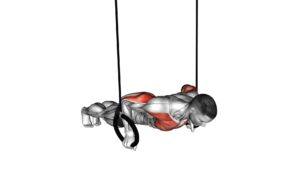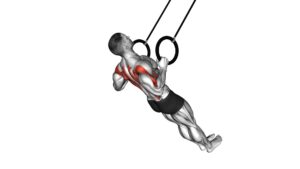Suspended Abdominal Fallout – Video Exercise Guide & Tips

Get ready to sculpt your abs with the suspended abdominal fallout exercise! In this video exercise guide, we'll show you the proper technique and form for maximum effectiveness.
Watch This Exercise Video
Whether you're a beginner or a fitness enthusiast, we've got modifications and progressions for all fitness levels.
Plus, we'll share common mistakes to avoid and provide tips for injury prevention.
Start working on your core strength today and get ready to feel the burn!
Key Takeaways
- Targets deep abdominal muscles (transverse abdominis)
- Activates obliques for rotational stability
- Improves overall stability and proprioception
- Reduces the risk of falls and injuries
Benefits of Suspended Abdominal Fallout
You will experience three key benefits when performing the suspended abdominal fallout exercise.
This exercise is highly effective for improving core strength and stability training.
Firstly, the suspended abdominal fallout targets your deep abdominal muscles, also known as the transverse abdominis. By engaging these muscles, you can enhance your core strength, which is essential for maintaining proper posture and stability in daily activities.
Secondly, this exercise also activates your obliques, the muscles on the sides of your abdomen. Strengthening the obliques can improve your rotational stability, allowing you to move with control and prevent injury during dynamic movements.
Lastly, the suspended abdominal fallout challenges your overall stability by forcing you to resist the movement of the suspension straps. This helps to improve your proprioception, or your body's awareness of its position in space. By enhancing your stability, you can perform other exercises more effectively and reduce the risk of falls or injuries.
Incorporating the suspended abdominal fallout into your workout routine won't only enhance your core strength but also improve your stability and overall performance.
Equipment Needed for the Exercise
To perform the suspended abdominal fallout exercise, you'll need specific equipment. The primary piece of equipment needed for this exercise is suspension straps. These straps are adjustable in length and can be attached to a stable anchor point, such as a door frame, pull-up bar, or sturdy beam.
The advantages of using suspension equipment for the suspended abdominal fallout are numerous. Firstly, suspension straps allow for a wide range of modifications and variations to target different muscle groups and increase or decrease the level of difficulty. Secondly, the instability created by the suspension straps engages the core muscles even more, making the exercise more challenging and effective in strengthening the abdominal muscles.
Additionally, suspension equipment provides a versatile and portable option for working out, as they can be easily set up and used in various environments, such as at home, in the gym, or even outdoors.
Proper Technique and Form for Maximum Effectiveness
To perform the suspended abdominal fallout exercise with maximum effectiveness, ensure that you maintain a stable and controlled body position throughout the movement. This exercise primarily targets your core muscles, so it's important to engage them properly. Start by positioning yourself in the suspension trainer with your feet slightly wider than hip-width apart. Keep your body in a straight line from head to heels, and avoid any sagging or arching in your lower back.
As you begin the movement, exhale and brace your core muscles by pulling your belly button towards your spine. This engagement will help stabilize your body and protect your lower back. Throughout the exercise, it's crucial to maintain this core engagement and control your breathing. Inhale as you lower your body towards the ground, and exhale as you return to the starting position.
Modifications and Progressions for All Fitness Levels
What are some ways to modify and progress the suspended abdominal fallout exercise for all fitness levels?
Whether you're a beginner or an advanced fitness enthusiast, there are various modifications and progressions you can incorporate into your suspended abdominal fallout routine to match your fitness level and goals.
For beginners, a modification of the exercise can be to perform the movement with bent knees instead of straight legs. This reduces the intensity and places less strain on the abs, making it more accessible for those with lower core strength.
To progress the exercise for intermediate fitness levels, you can try extending your legs further out or increasing the duration of the exercise. This will engage your abdominal muscles more intensely and challenge your stability.
For advanced fitness levels, you can incorporate additional equipment such as a weighted vest or ankle weights to increase the resistance. This will further enhance the effectiveness of the exercise and stimulate muscle growth.
Remember to always listen to your body and progress at a pace that feels challenging yet manageable. By incorporating modifications and progressions into your suspended abdominal fallout routine, you can continually challenge your muscles and achieve your fitness goals.
Common Mistakes to Avoid and Tips for Injury Prevention
Regularly check your form and technique to prevent common mistakes and reduce the risk of injury during the suspended abdominal fallout exercise. Proper form is crucial for maximizing the effectiveness of the exercise and minimizing the chances of injury.
One common mistake to avoid is allowing your lower back to sag or arch excessively. This can put unnecessary strain on your spine and lead to discomfort or injury. To prevent this, engage your core muscles and maintain a neutral spine throughout the movement.
Another mistake to watch out for is using momentum to complete the exercise. This can take away from the effectiveness of the exercise and increase the risk of injury. Instead, focus on controlled movements and use your abdominal muscles to lift and lower your body.
Injury prevention tips for the suspended abdominal fallout exercise include warming up properly before starting the exercise to increase blood flow to the muscles and reduce the risk of muscle strains. It's also important to start with lighter resistance or modifications if you're a beginner or new to the exercise. Gradually increase the difficulty as you become more comfortable and stronger.
Additionally, listen to your body and stop the exercise if you experience any pain or discomfort. Remember, it's better to take a break and prevent an injury than to push through and worsen the situation.
Frequently Asked Questions
How Many Sets and Repetitions Should I Do for Suspended Abdominal Fallout?
To get the most out of suspended abdominal fallout, it's important to consider injury prevention.
Start with 2-3 sets of 10-15 repetitions, focusing on proper form.
Gradually increase the intensity and difficulty as you progress.
Remember, variations and modifications can be made to suit your fitness level and goals.
Always listen to your body and consult a professional trainer if needed.
Stay consistent, and you'll see results while keeping yourself safe.
Can I Perform Suspended Abdominal Fallout if I Have a Lower Back Injury?
If you have a lower back injury, it isn't recommended to perform the suspended abdominal fallout exercise. However, there are alternatives you can try that are safer for your condition.
This exercise primarily targets the abdominal muscles and can help improve core strength and stability. It's important to consult with a healthcare professional or a certified trainer to find exercises that are suitable for your specific needs and to prevent further injury.
Is It Necessary to Have a Suspension Trainer to Perform This Exercise?
To perform modified abdominal exercises, you don't necessarily need a suspension trainer. There are ways to work on core stability without one. Suspension trainers can be useful for engaging multiple muscle groups, but you can still achieve similar results with other exercises.
Focus on exercises that challenge your core, such as planks, Russian twists, or leg raises. Remember to always listen to your body and modify any exercise if you have a lower back injury.
Can Suspended Abdominal Fallout Help With Weight Loss?
Suspended abdominal fallout is a highly effective exercise for developing core strength. By engaging your abdominal muscles and stabilizing your body in a suspended position, you can challenge your core in a unique way.
While this exercise alone may not directly lead to weight loss, it can be a valuable addition to a comprehensive weight loss program. Incorporating suspended abdominal fallout into your routine can help strengthen your core, improve posture, and support overall body strength and conditioning.
Are There Any Alternatives to Suspended Abdominal Fallout for Targeting the Abdominal Muscles?
Looking for alternative exercises to target your abdominal muscles? If you're not a fan of suspended abdominal fallout, there are other options you can try.
Plank exercises, Russian twists, and bicycle crunches are all great alternatives that can effectively work your abs.
And if you're a beginner, don't worry! You can modify the suspended abdominal fallout by starting with shorter holds and gradually increasing the duration as you build strength.
Conclusion
In conclusion, the suspended abdominal fallout is a highly effective exercise for strengthening the core muscles. By using the proper technique and form, individuals of all fitness levels can benefit from this exercise.
It's important to avoid common mistakes and follow the modifications and progressions to prevent injuries.
Incorporating this exercise into your fitness routine can help you achieve maximum effectiveness in strengthening your abdominal muscles.

Author
Years ago, the spark of my life’s passion ignited in my mind the moment I stepped into the local gym for the first time. The inaugural bead of perspiration, the initial endeavor, the very first surge of endorphins, and a sense of pride that washed over me post-workout marked the beginning of my deep-seated interest in strength sports, fitness, and sports nutrition. This very curiosity blossomed rapidly into a profound fascination, propelling me to earn a Master’s degree in Physical Education from the Academy of Physical Education in Krakow, followed by a Sports Manager diploma from the Jagiellonian University. My journey of growth led me to gain more specialized qualifications, such as being a certified personal trainer with a focus on sports dietetics, a lifeguard, and an instructor for wellness and corrective gymnastics. Theoretical knowledge paired seamlessly with practical experience, reinforcing my belief that the transformation of individuals under my guidance was also a reflection of my personal growth. This belief holds true even today. Each day, I strive to push the boundaries and explore new realms. These realms gently elevate me to greater heights. The unique combination of passion for my field and the continuous quest for growth fuels my drive to break new ground.







